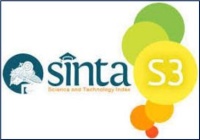Morfologi Thalus Lichen di Kawasan Jalur Pendakian Bukit Mongkrang Kecamatan Tawangmangu Kabupaten Karanganyar
Abstract
Lichen is an association of fungi and algae, morphologically and physiologically unified as a single entity. Lichen is categorized as plants characterized by a thallus-like form. The aim of this research was to investigate the thallus morphology of lichens along the hiking trails of Bukit Mongkrang, Tawangmangu District, Karanganyar Regency, Central Java Province. The research utilized an exploratory method involving exploration of locations to obtain necessary samples. Purposive sampling was employed to select research locations comprising three stations at varying altitudes. Subsequently, lichen morphology samples were identified. The results revealed three types of thalli: Crustose, Foliose, and Fruticose, with Foliose being the most dominant type at 335 individuals, and Crustose the least at 132 individuals. The most dominant surface morphology of lichen thalli was Maculae details in the species Polyblastidium albicans (Pers.) S.Y. Kondr, Lokos & Hur, while the least common surface detail was Cephalodia in the species Lepraria casiella R.C. Harris. Lichen reproductive structures identified included two types: sexual and asexual. Sexual reproductive structures consisted of Apothecia, Perithecia, and Pycnidia, while asexual reproductive structures included Isidia and Soredia. The most dominant sexual reproductive structure found was Apothecia in the species Lecanora glabrata (Ach.) Malme, and the least common was Pycnidia in the species Anaptychia palmulata (Michaux) Vain. Morphological differences among lichen types were influenced by variations in altitude, air temperature, humidity, and light intensity. Lichen was most abundant at elevations ranging from 1,712 to 1,844 meters above sea level.
Keywords
Full Text:
Full PaperReferences
Basten, F., Hasairin, A., & Sudibyo, M. (2021). Keanekaragaman Jenis Liken (Lumut Kerak) di Kawasan Tahura Bukit Barisan. Surabaya: Global Aksara Pers.
Bill, B., Malcolm, N., & Knight, A. (2014). New Zealand’s Foliose Lichens an Illustrated Key. New Zealand: Manaaki Whenua Press.
Estiyantara, N. S. (2022). Analisis Sinergi Pokdarwis Desa Gondosuli dan Perhutani dalam Pengelolaan Wisata Bukit Mongkrang Karanganyar Jawa Tengah. Altasia: Jurnal Pariwisata Indonesia, 4(1), 34-44. https://doi.org/10.37253/altasia.v4i1.6287
Fithri, S. Z. E. (2018). Identifikasi Lichenes di Brayeun Kecamatan Leupung Kabupaten Aceh Besar. In Prosiding Seminar Nasional Biotik (pp. 151-156). Banda Aceh, Indonesia: Biology Education Study Program, Faculty of Tarbiyah and Teacher Training, Ar-Raniry State Islamic University.
GBIF (Global Biodiversity Information Facility). Retrieved March 12, 2024, from GBIF. Interactwebsite: https://www.gbif.org/
Goward, T. (1999). The Lichens of British Columbia Part 2 Fruticose Species. British Columbia: Ministry of Forests Research Branch.
Hutasuhut, M. A., Febriani, H., & Devi, S. (2021). Identifikasi dan Karakteristik Habitat Jenis Lumut Kerak di Taman Wisata Alam Sicikeh-Cikeh Kabupaten Dairi Sumatera Utara. Jurnal Biolokus, 4(1), 43-54. https://doi.org/10.30821/biolokus.v4i1.957
Madjeni, H. D., Bullu, N. I., & Hendrik, A. C. (2019). Keanekaragaman Lumut Kerak (Lichen) sebagai Bioindikator Pencemaran Udara di Taman Wisata Alam Camplong Kabupaten Kupang. Indigenous Biologi : Jurnal Pendidikan dan Sains Biologi, 2(2), 65-72. https://doi.org/10.33323/indigenous.v2i2.37
Mulyadi, M. (2018). Jenis Lichenes di Kawasan Gugop Pulo Breuh Kecamatan Pulo Aceh Kabupaten Aceh Besar. BIOTIK: Jurnal Ilmiah Biologi Teknologi dan Kependidikan, 5(2), 83-87. https://doi.org/10.22373/biotik.v5i2.3014
Muvidha, A. (2020). Lichen di Jawa Timur. Tulungagung: Akademia Pustaka.
Nuryani, E., Hutasuhut, M. A., & Idami, Z. (2023). Keragaman Lumut Kerak (Lichenes) di Resort 6 Taman Nasional Batang Gadis (TNBG) Sumatera Utara. BIOEDUSAINS: Jurnal Pendidikan Biologi dan Sains, 6(1), 138-150. https://doi.org/10.31539/bioedusains.v6i1.5776
Orange, A. (2020). Lithocalla (Ascomycota, Lecanorales), a New Genus of Leprose Lichens Containing Usnic Acid. Lichenologist, 52(6), 425-435. https://doi.org/10.1017/S0024282920000419
Pratama, A., & Trianto, M. (2020). Diversity of Lichen in Mangrove Forest of Tomoli Village Parigi Moutong Regency. BIO-EDU: Jurnal Pendidikan Biologi, 5(3), 140-150. https://doi.org/10.32938/jbe.v5i3.730
Rahayu, R. C., & Roziaty, E. (2018). Studi Lichen pada Berbagai Tumbuhan Inang di Kecamatan Laweyan, Kota Surakarta. In Seminar Nasional Pendidikan Biologi dan Saintek III (pp. 338-344). Surakarta, Indonesia: Universitas Muhammadiyah Surakarta.
Raslina, H., Dharmawibawa, I. D., & Safnowandi, S. (2018). Diversity of Medicinal Plants in National Park of Rinjani Mountain in Order to Arrange Practical Handout of Phanerogamae Systematics. Bioscientist: Jurnal Ilmiah Biologi, 4(1), 1-6. https://doi.org/10.33394/bioscientist.v4i1.210
Roziaty, E. (2016). Lichen : Karakteristik Anatomis dan Reproduksi Vegetatifnya. Jurnal Pena Sains, 3(1), 44-53. https://doi.org/10.21107/jps.v3i1.1118
Suniyanti, S., Mahrus, M., & Mertha, I. G. (2022). The Diversity of Lichens in the Tourist Area of the Stokel Waterfall Central Lombok. Jurnal Biologi Tropis, 22(2), 660-667. https://doi.org/10.29303/jbt.v22i2.3586
Supriati, R., Helmiyetti, H., & Agustian, D. (2021). Keragaman Lumut Kerak pada Tanaman Teh (Camellia sinensis (L.) Kuntze) di Perkebunan Teh PT. Sarana Mandiri Mukti Kabupaten Kepahiang Provinsi Bengkulu. Berita Biologi, 20(1), 137-145. https://doi.org/10.14203/beritabiologi.v20i1.3944
Susilawati, P. R. (2017). Fructicose dan Foliose Lichen di Bukit Bibi, Taman Nasional Gunung Merapi. Jurnal Penelitian, 21(1), 12-21.
Yuliani, R., Imaningsih, W., & Yuwati, T. W. (2021). Lichen as Bioindicator of Air Quality at Buffer Zone of Banjarbaru Town. Jurnal Galam, 2(1), 54-65. https://doi.org/10.20886/glm.2021.2.1.54-65
DOI: https://doi.org/10.33394/bioscientist.v12i1.11172
Refbacks
- There are currently no refbacks.

This work is licensed under a Creative Commons Attribution-ShareAlike 4.0 International License.

Bioscientist : Jurnal Ilmiah Biologi is licensed under a Creative Commons Attribution-ShareAlike 4.0 International License
Editorial Address: Pemuda Street No. 59A, Catur Building Floor I, Mataram City, West Nusa Tenggara Province, Indonesia











